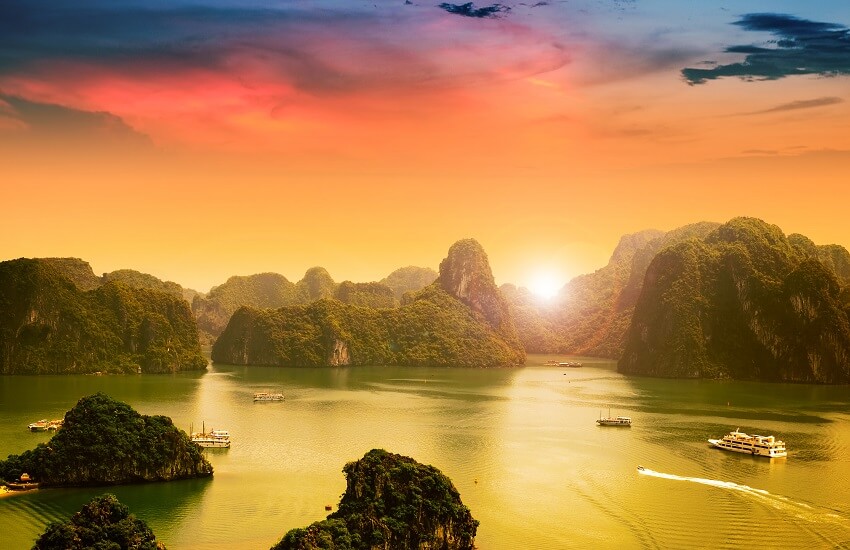


Vietnam’s Halong Bay is one of the country’s most famous natural attractions, with this beautiful bay and all its islands on the must-visit lists of the majority of travellers who come to the nation for a getaway.
If you’ve never seen the spectacle for yourself, you really do need to travel to the area to take it in – there’s a reason why it’s on included in so many itineraries, after all.
Halong Bay is a UNESCO World Heritage Site that covers some 150,000 hectares. It is located on the Gulf of Tonkin in the north eastern province of Quang Ninh. Aside from its size, the most impressive thing about the bay is the 1,600 islands and islets that rise up out of the water.
The majority of the isles here are completely uninhabited and it is the fact that the landscape has remained so unspoiled, coupled with its incredible natural beauty and geological significance, that makes it such a special place.
It’s worth learning a bit more about the geology behind the stunning surroundings, as this will only make you appreciate it more.
All of the islands and surrounding cliffs are made of limestone, which has been steadily eroded over the centuries to create what’s left today – the towering pillars topped with greenery and the sheer cliffs that enclose the bay. It’s an outstanding example of a karst landscape, which has then been eroded into ever more interesting and impressive formations by the continuous movement of the sea.
As well as the tall pillars that are so characteristic of Halong Bay, it holds many other striking landmarks, including arches and caves, all of which can be explored during a visit to this incredible spot.
As you’d probably expect, the only way to fully appreciate this vast natural attraction is to go on a boat tour, which will allow you to get close to the limestone pillars, set foot on some of the larger islands, and even go inside the bigger sea caves.
Taking a tour on a traditional Junk Boat is the best way to see this spectacle, with these boats the quintessential image of south-east Asia. Their distinctive orange sails look almost like wings and stand out wonderfully against the grey of the rocks and green of the foliage.
Gliding across the water in among the isles is an incredibly peaceful way to spend a couple of days and you can imagine what the shores of Vietnam must have looked like in centuries gone by, when traders and fishermen were the only ones who sailed these waters.
To get a really close look at the rock formations, and to enter the caves, you can take to kayaks, paddling your way under arches, around pillars and into tunnels that open out into vast caverns, with stalactites dripping from the roofs.
You can also dive into the emerald green waters wearing a mask and snorkel, which will enable you to see the diverse life that inhabits the coastline. There are stunning corals, including staghorn coral and sun mushrooms, as well as a variety of tropical fish. Anemone fish dart in between the tentacles of their protective homes, sergeant fish patrol the top couple of metres of the water, and butterfly fish flit among the corals.
On land, there are glorious sandy beaches that are worthy of any postcard scene, where you can spend an hour or two relaxing and soaking up a bit of sunshine.
While the natural side of Halong Bay is the main attraction and, understandably, the spectacle most people want to see, there are also some fascinating communities that live around, and indeed on, the bay.
Visiting a floating fishing village is an eye-opening experience, with these small communities bobbing on the surface and supporting whole families. The main source of income here is, naturally, fishing, with the majority of the fishermen going out in small boats to land their catch, which they then sell on to the larger boats that return to the mainland.
They still use very traditional fishing techniques, casting and retrieving their nets by hand – you may spot them out in their rowing boats as they haul their catch in. The villages are also where you’ll find floating markets, where people buy rice, vegetables and other produce. They sell local handicrafts too, which can make fantastic souvenirs and provide a wonderful memento of your time in Halong Bay.
Take a look at our Vietnam Multi Centre Holidays page for inspirational ideas of how to add a visit to Halong Bay in to your Vietnam itinerary. We can also combine a visit to Halong Bay in to any Far East package, so if you can’t find what you’re after please contact us so we can help.
Inspired by the guide? We’ve handpicked a few holidays that bring it to life—perfect for turning travel ideas into reality.